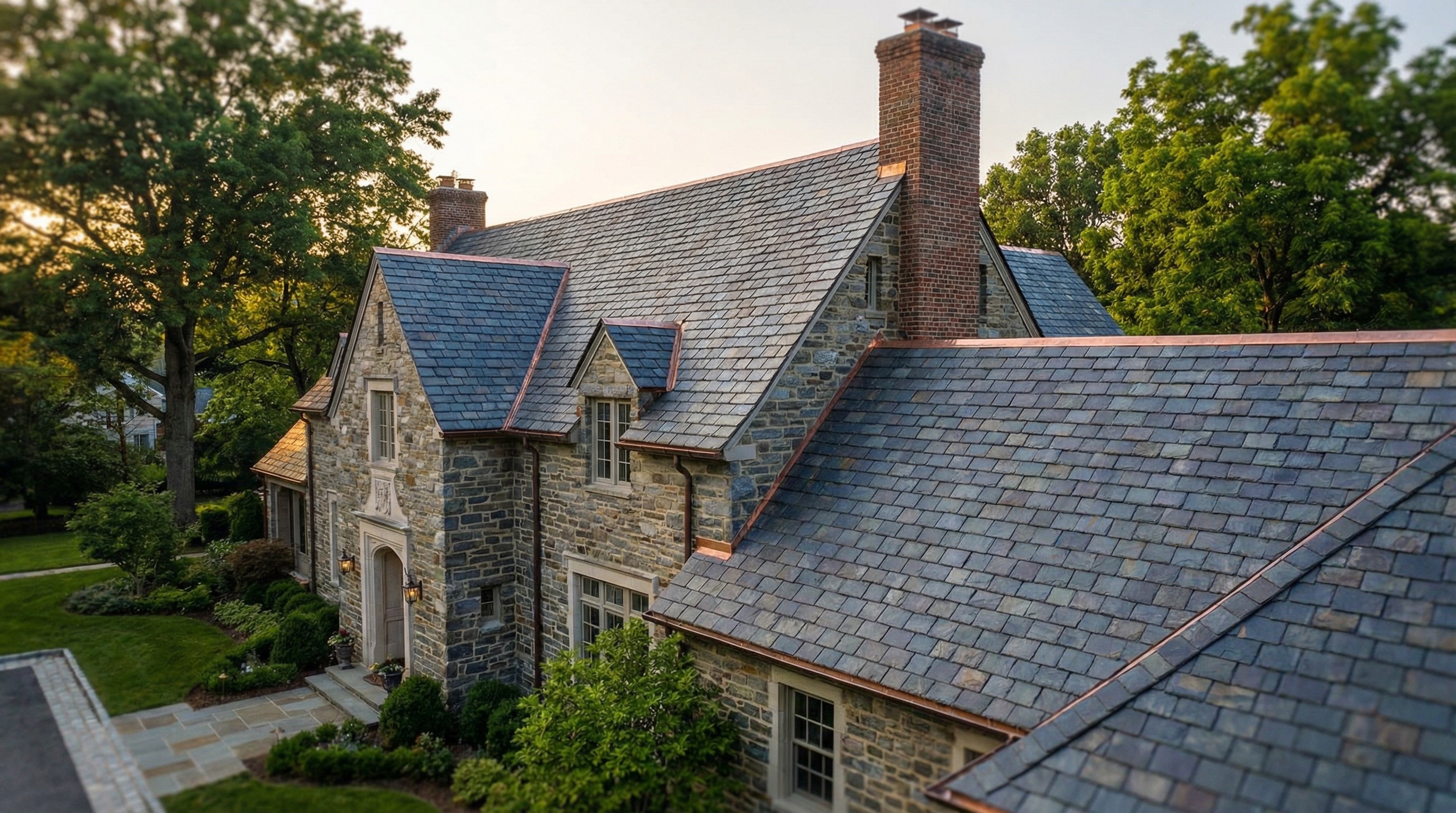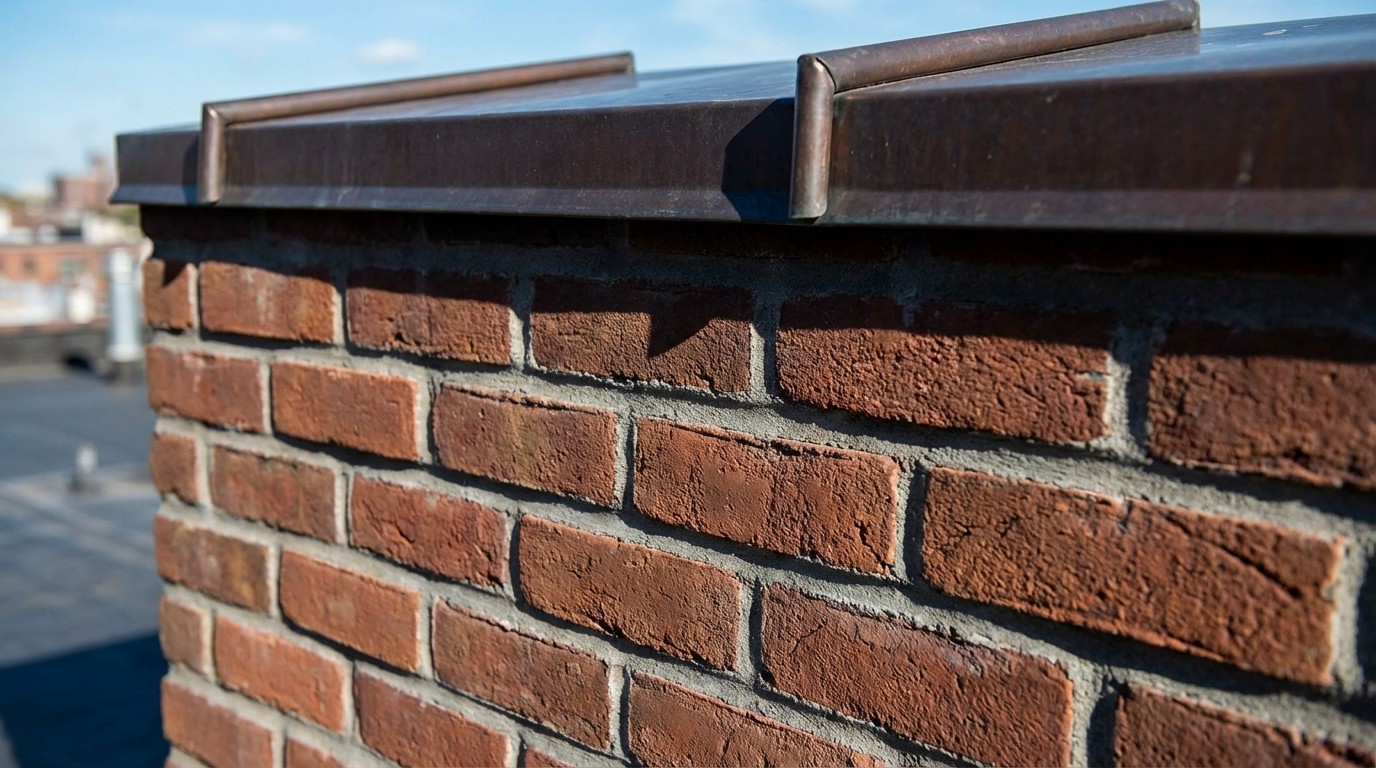Before you commit to this premium material, let's walk through the different types of slate, what you can realistically expect to pay, and how to find a contractor who truly knows slate installation.
What Is a Slate Roof
A slate roof uses natural stone tiles split into thin sheets. Slate is known for exceptional durability, fire resistance, and beauty, which makes it a premium roofing choice. That said, slate comes with two important considerations: it's expensive and heavy, which means you'll need specialized installation and a roof structure that can handle the weight.
Slate itself is metamorphic rock, formed over millions of years under intense heat and pressure deep underground. Quarries extract large blocks of this rock, then split them along natural grain lines into flat tiles. The result is a roofing material that has been protecting homes for centuries. In fact, slate is the oldest roofing material still in use today.
Types of Slate Roof Tiles
Not all slate is the same. The type you choose affects how long your roof lasts, what it looks like, and what you pay.
Hard Slate vs. Soft Slate
Hard slate is denser and significantly more durable, while soft slate tends to weather faster and won't last as long. Vermont and certain Pennsylvania quarries produce hard slate, while softer varieties come from other regions. If longevity is your priority, hard slate is worth the extra cost.
Common Slate Colors and Grades
Slate comes in more colors than most people expect. The color depends on where the stone was quarried and its mineral content.
Gray and black: The most traditional choice, common on historic homes
Green: Popular in the Northeast, with a distinctive look
Purple and red: Rarer and typically more expensive
Unfading vs weathering: Some slates keep their original color forever, while others gradually shift over decades
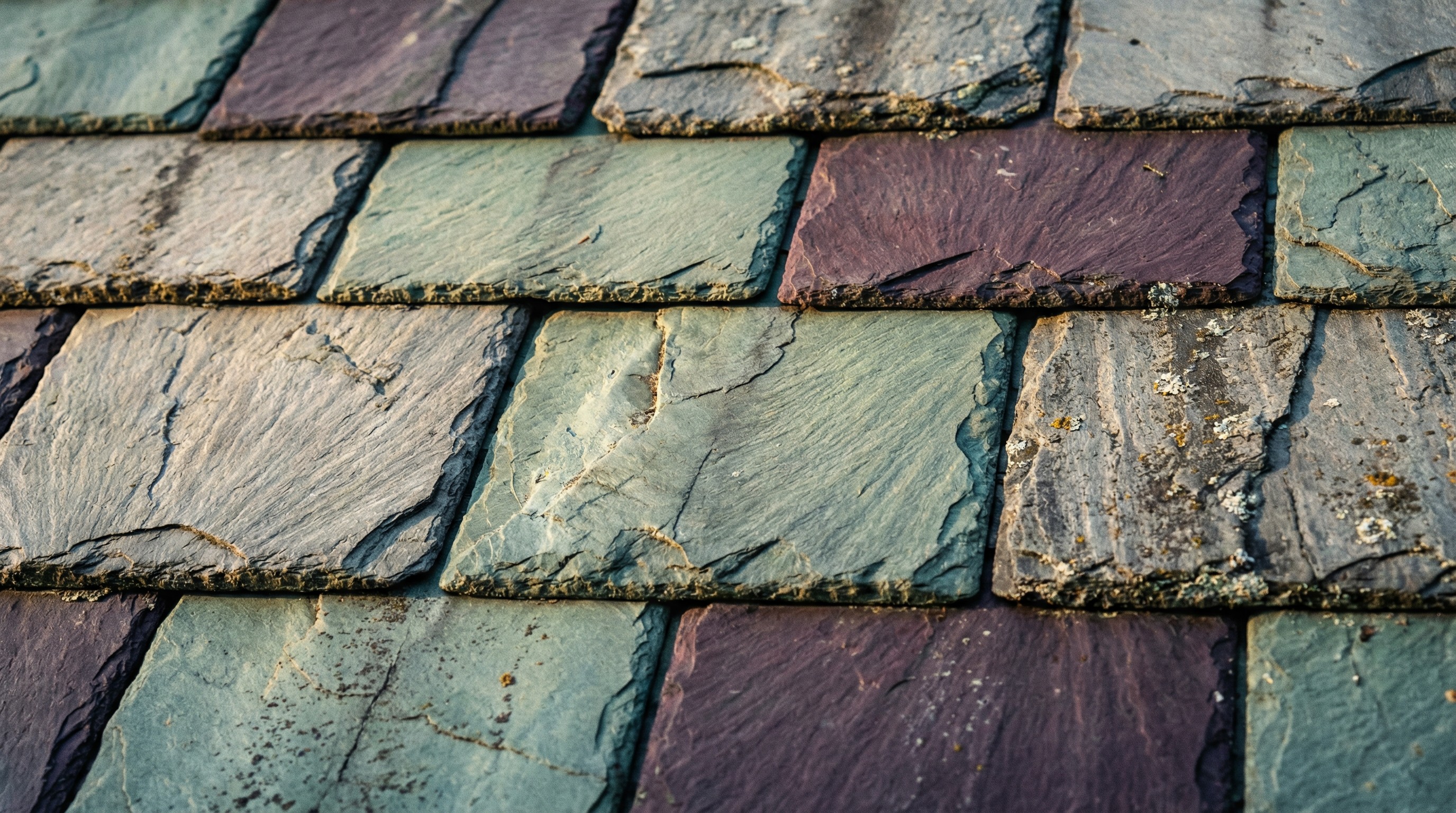
As you shop for slate, contractors will mention different grades.
Slate Tile Dimensions and Thickness
Standard slate tiles range from about 12 inches to 24 inches in length. Thickness varies between 3/16 inch and 1/2 inch. Thicker tiles weigh more but tend to last longer. Your contractor will recommend dimensions based on your roof pitch and the look you want.
Pros of a Slate Tile Roof
Let me explain why so many homeowners choose natural slate despite the higher upfront cost.
Exceptional longevity
Slate outlasts every other roofing material by a wide margin. A properly installed slate roof can protect your home for a century or more. Many slate roofs outlast the homeowners who install them.
Natural beauty and curb appeal
Each slate tile is unique. Natural color variations and texture create a look that synthetic materials try to replicate but cannot quite match. On the right home, slate makes a statement.
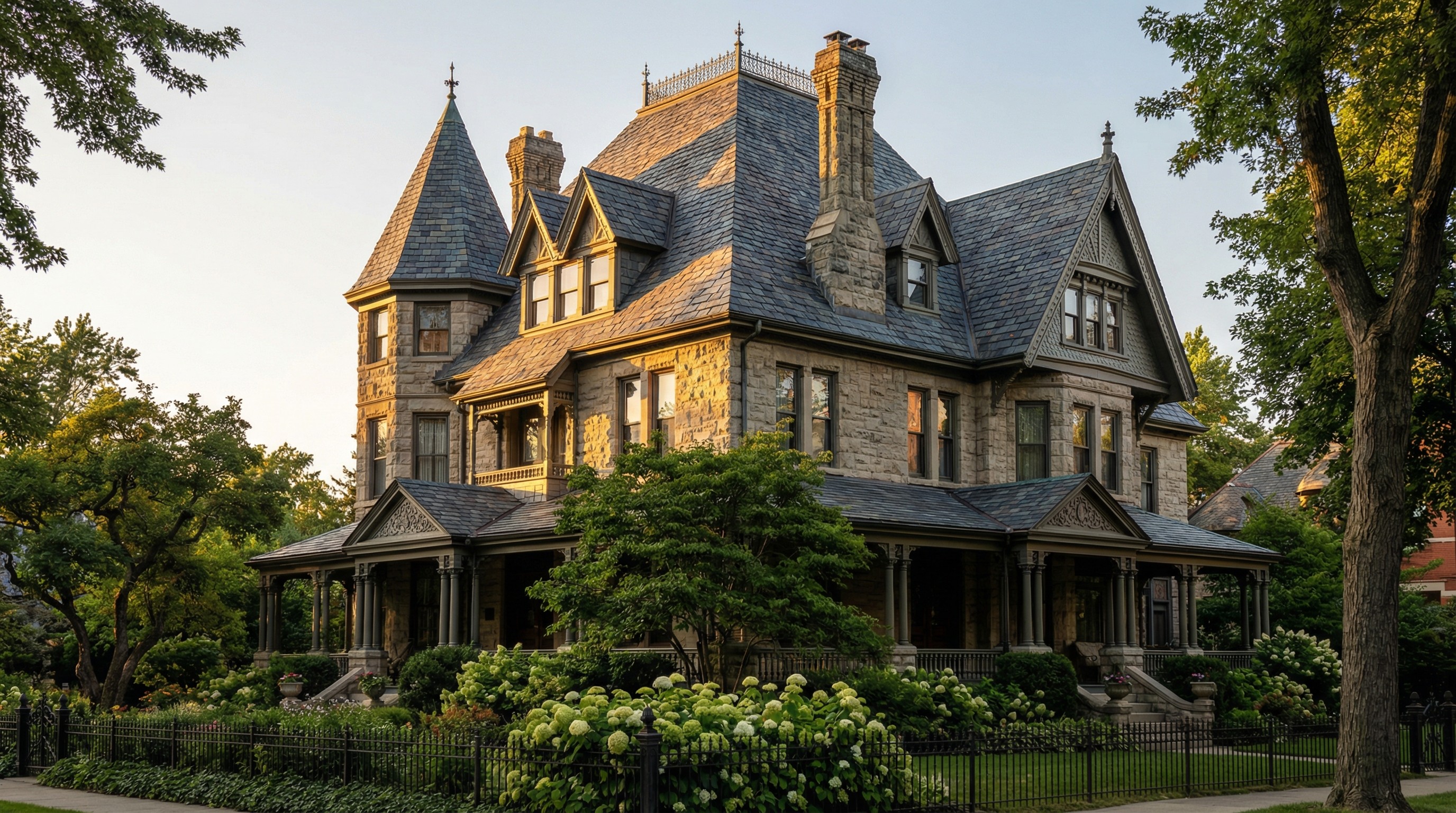
Fire and weather resistance
Natural stone does not burn. Slate earns a Class A fire rating, the highest available. It also holds up well against wind, rain, and temperature swings. Large hail can occasionally crack individual tiles, but overall, slate handles weather better than most alternatives.
Low long-term maintenance
Once properly installed, slate requires minimal upkeep. You will not deal with the frequent repairs common with asphalt shingles. The main maintenance involves periodic inspections and replacing the occasional cracked tile.
Increased home value
A slate roof signals quality. In neighborhoods with historic homes, slate often commands a premium at resale. Buyers recognize that they will not have to think about the roof for decades.
Cons of a Slate Roof
Now, let's be honest-slate isn't right for every home or budget. Here's what you need to know about the real challenges.
High upfront cost
You're looking at three to five times the cost of a standard asphalt roof-which understandably makes many homeowners pause.
Heavy weight requires structural support
Slate tiles weigh between 800 and 1,500 pounds per roofing square. A roofing square covers 100 square feet. Many homes, especially newer construction, were not built to handle that load. Structural reinforcement adds to the project scope and cost.
Difficult to find qualified installers
Slate roofing requires specialized skills that most roofers do not have. Finding experienced slate contractors can be challenging, especially outside historic areas or regions with local quarries.
Fragile tiles can crack if walked on
Despite being durable against weather, individual slate tiles are brittle. They crack under foot traffic or if someone steps in the wrong spot. This makes repairs and inspections more complicated than with other roofing materials.
Limited style options compared to other materials
Slate works best on traditional home styles like Colonial, Victorian, and Tudor. Modern applications exist, but the options are narrower than with metal or asphalt.
How Long Does a Slate Roof Last?
Slate is the longest-lasting roofing material you can buy. Hard slate typically lasts 75 to 200 years. Soft slate lasts 50 to 125 years.
Three factors determine actual lifespan: the type of slate, installation quality, and your local climate. Interestingly, the fasteners and flashing often fail before the slate itself. That is why quality installation matters so much. A poorly installed slate roof might only last 40 years, while the same materials installed correctly could last 150.
How Much Does a Slate Roof Cost?
Worried about overpaying? Slate roofing projects can vary widely in price, so it pays to be proactive. Get at least three detailed quotes from different contractors, and ask them to break down what drives the costs-such as slate type, roof complexity, and required structural work. Understanding these price factors makes it easier to compare bids and ensure you’re paying a fair rate for both materials and installation. Don’t hesitate to ask questions about any line item you don’t understand before making your decision.
I know cost is probably your first question-and I'll give it to you straight: slate is the most expensive roofing option you'll find.
Slate Roof Cost Per Square Foot
Natural slate roofing typically costs $15 to $30 per square foot for materials alone. Fully installed, expect to pay $22 to $45 per square foot. The range is wide because so many variables affect the final price.
Factors That Affect Slate Roofing Prices
Several things push the price up or down:
Slate type and origin: Imported slate from Spain or China often costs less than domestic Vermont slate
Roof complexity: Steep pitches, multiple valleys, and dormers add labor time
Structural reinforcement: If your roof framing cannot handle the weight, strengthening it adds cost
Contractor experience: Skilled slate roofers charge more, but their work lasts longer
Your location: Labor rates and material availability vary by region
Slate Roof Cost Compared to Other Roofing Materials
Roofing Material | Cost per Sq Ft (Installed) | Typical Lifespan |
|---|---|---|
Asphalt shingles | $4 to $8 | 15 to 30 years |
$8 to $16 | 40 to 70 years | |
Synthetic slate | $12 to $25 | 30 to 50 years |
Natural slate | $22 to $45 | 75 to 200 years |
When you look at cost per year of service, slate becomes more competitive. But the upfront investment is still substantial.
Natural Slate vs. Synthetic Slate Roofing
If you love the slate look but worry about cost or weight, synthetic options exist. Here is how they compare.
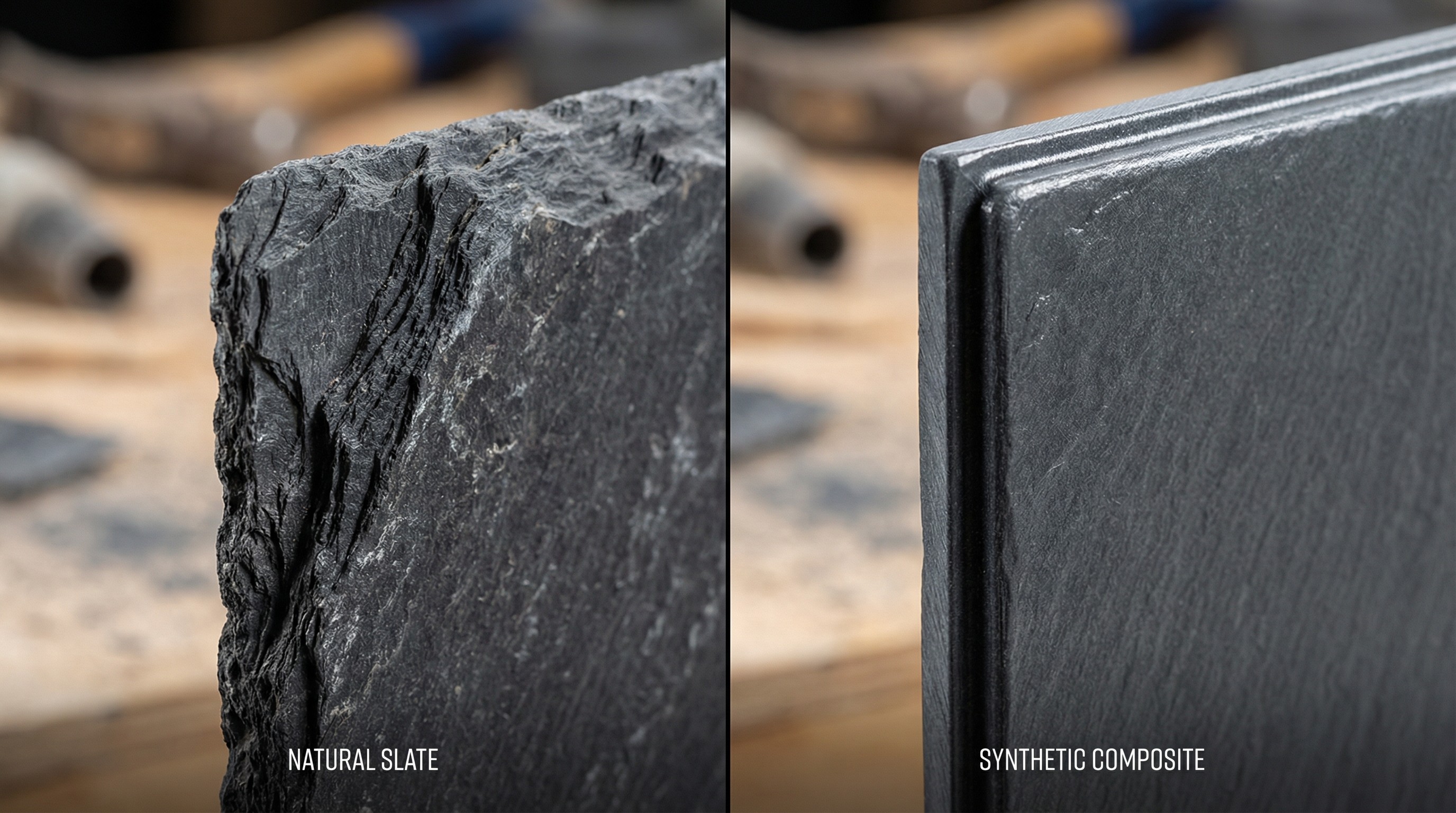
Natural Slate Roof Tiles
Natural slate offers authentic beauty, the longest lifespan, and the highest resale value. It works best for homeowners committed to a forever roof on a home that can support the weight.
Synthetic Slate Roofing Shingles
Synthetic slate is made from rubber, plastic, or polymer composites designed to mimic real slate. These products weigh significantly less, cost less, and are easier to install. The tradeoff is lifespan. Synthetic slate typically lasts 30 to 50 years rather than a century or more.
How to Choose Between Natural and Synthetic Slate
The right choice depends on your situation:
Budget: Synthetic costs roughly half as much as natural slate
Home structure: Synthetic works on homes that cannot support heavy natural slate
Longevity goals: Natural slate wins if you plan to stay in your home for decades or pass it to the next generation
Aesthetic priority: Natural slate has depth and variation that synthetics cannot fully replicate
Neither option is universally better. It depends on what matters most to you.
Slate Roof Maintenance
Slate requires less maintenance than most roofing materials, but it is not maintenance-free.
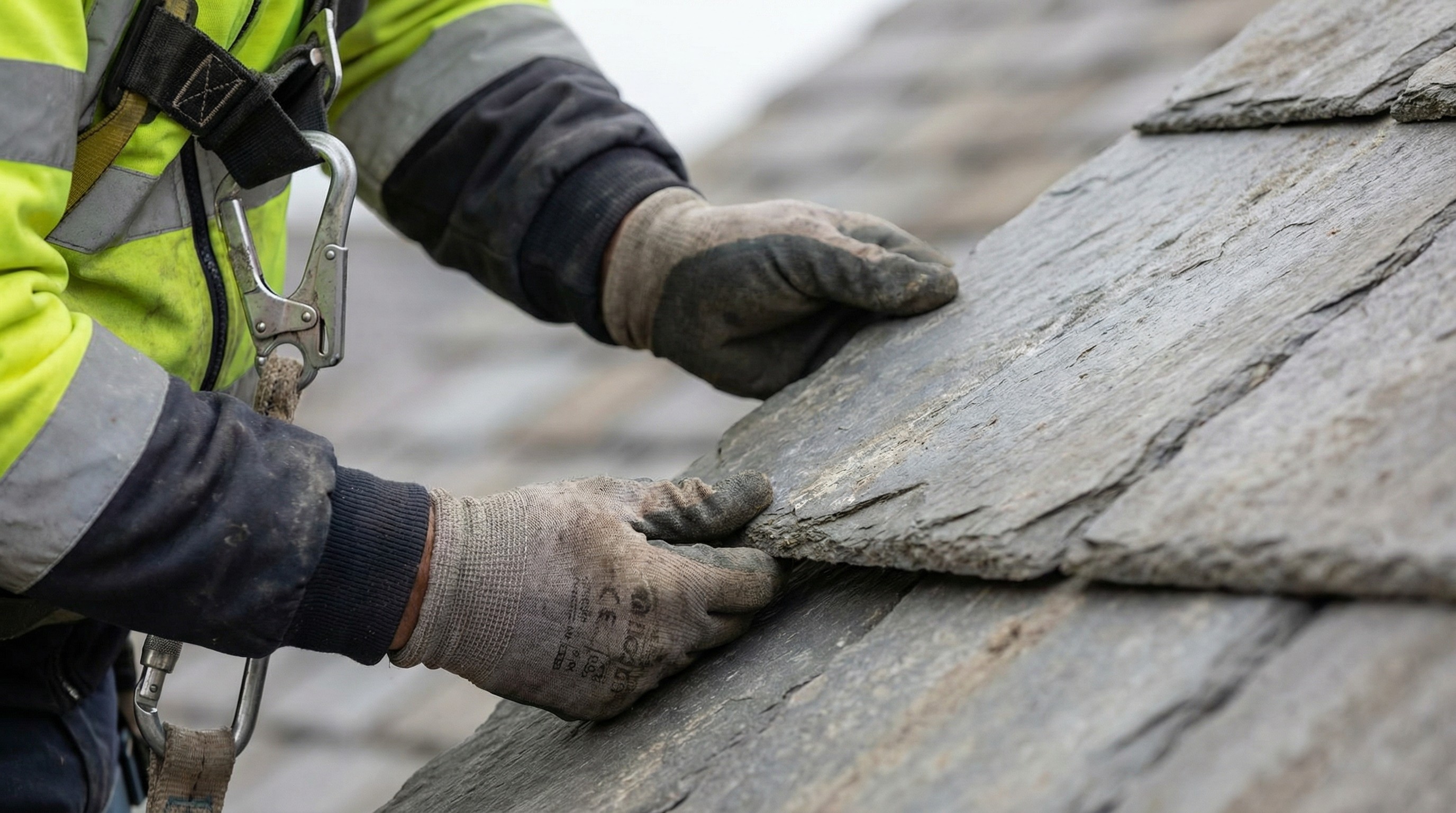
Annual visual inspections from the ground help catch problems early. Look for cracked, slipped, or missing tiles. Replacing broken tiles promptly prevents water from damaging the underlayment beneath.
Keep gutters clear so water drains properly. The flashing around chimneys, vents, and valleys often fails before the slate itself. During inspections, pay attention to those components.
Can You Walk on a Slate Roof
Generally, no. Slate tiles crack under weight and improper foot placement.
Professional roofers use special techniques and equipment to work on slate roofs without causing damage. They distribute their weight carefully and know where to step. Homeowners walking on their own slate roof often cause more damage than they realize. If you notice a problem, call a professional rather than climbing up yourself.
What Warranties Come With Slate Roofing
Warranties for slate work differently than warranties for other roofing materials.
Material Warranties for Slate Tiles
Natural slate often has limited or no manufacturer warranty because it is a natural product with inherent variations. Some quarries offer guarantees on specific grades. Synthetic slate typically comes with manufacturer warranties of 30 to 50 years.
Workmanship Warranties From Your Contractor
This is where protection matters most. Ask contractors what they cover and for how long. A quality slate installer will stand behind their work for at least 10 years. Get everything in writing before signing any contract.
How to Find a Qualified Slate Roof Contractor
Installation quality determines whether your slate roof lasts 50 years or 150 years. The difference is that significant.
Look for contractors with specific slate experience, not just general roofers who occasionally work with slate. Ask to see completed projects and request references from past slate customers. Verify insurance coverage and ask about warranty terms before making a decision.

